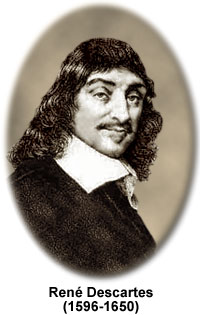René Descartes
(1596-1650)

René Descartes is often referred to as the father of modern philosophy for his revolutionary breach from Aristotelian thought. In its place he attempted to establish a dualistic system that rested on a clear distinction between the mind, the origin of thought, and matter. He is, perhaps, most commonly remembered for his philosophical declaration, "Cogito, ergo sum" (I think, therefore I am). However, in addition to his many philosophical reflections, Descartes made significant contributions to mathematics and the sciences, including optics.
Born in La Haye, France on March 31, 1596, Descartes was raised in a family of minor nobility. His father served in Parliament and his mother died when he was still an infant. Though his father remarried, Descartes and his siblings were reared by their maternal grandmother and a nurse. In his youth, Descartes was educated at a Jesuit school and displayed an exceptional mental capacity. He graduated from college at the age of eighteen and had received a law degree by 1616, perhaps with the intention of entering Parliament like his father.
Descartes spent the period from 1618 to 1628 traveling extensively throughout Europe, at times a member of various military units. Though he was not often involved in combat, Descartes did come into contact with various notable intellectuals, such as physicist Isaac Beeckman who encouraged his scientific and mathematical pursuits. Perhaps even more influential on Descartes' life, however, was a set of three dreams he had in 1619, which he interpreted as a sign that all science was unified and could therefore be mastered by a single person if a correct method of knowing, or reasoning, was established. The majority of his life was dedicated to demonstrating that he had discovered such a method.
In 1629, Descartes settled at the university at Franeker, where he wrote the first draft of his philosophical work Meditations. Then, in 1630, he enrolled at the University of Leiden, but left the following year to travel through Denmark and Germany, continuing correspondence with various scholars. By 1633 he was ready to publish The World, but received information regarding the condemnation of Galileo Galilei for a publication supporting the notion that the Earth revolved around the sun. Since the same Copernican idea was central to The World, Descartes decided to delay its publication to a time when it might be received with more enthusiasm, or at least not mortal danger to himself. The work was eventually released in 1664, many years after the death of its author.
Descartes, however, did write many other works during his lifetime, including his Discourse on Method, published in 1637. The work contained an introductory section that outlined four general rules for using analysis to reduce any problem into its fundamental parts, and included a synthesis to construct solutions. This was followed by three appendices, "Dioptrics," "Meteors," and "Geometry," which were meant to act as illustrations of Descartes' rules of reasoning. Two of these three works contain the bulk of Descartes' contribution to the field of optics.
Within "Dioptrics," Descartes breaks down the problem of designing optical instruments, beginning by defining light and the human eye. During his examination of the nature of light, he provides the law of refraction, discovered independently from Willebrord Snell. Descartes then progresses to consider ways that eyesight might be enhanced, discussing different forms of instruments and lenses. Once he determines that a hyperbolic lens is the best type for use in telescopes, he describes how to construct a machine with which such lenses could be created.
The appendix known as "Meteors," is an examination of various meteorological phenomena, some of which also involve optics. In particular, Descartes offers a detailed theory of rainbows, which he supports through numerous inventive experiments. One of the more notable experiments successfully equates the colors of a rainbow with the colors that occur when light travels through a prism. This finding was later utilized by Isaac Newton, who explained the breakdown of sunlight into a succession of colors.
In his attempts to provide an understanding of knowledge to the world, Descartes completed a number of other significant works. He wrote Rules for the Direction of the Human Mind by 1628, but it was, like The World, published posthumously. However, in 1641 Descartes' Meditations on First Philosophy in Which Is Proved the Existence of God and the Immortality of the Soul was released, followed in 1644 by Principles of Philosophy.
Descartes numerous contributions garnered him a certain amount of fame during his lifetime, which sometimes had a detrimental effect upon him due to the unfavorable political and religious climate of the period. In September 1649, due to a variety of factors, Descartes accepted a request to act as philosophy instructor for Christina, the young, but powerful, Queen of Sweden. Particularly demanding, she required him to provide her daily lessons at 5:00 AM, though it interfered with his meditation schedule, and obliged him to compose various works in her honor, including a ballet in verse. While fulfilling one of his early morning appointments with her, Descartes caught a chill and developed pneumonia, dying ten days later on February 11, 1650.
